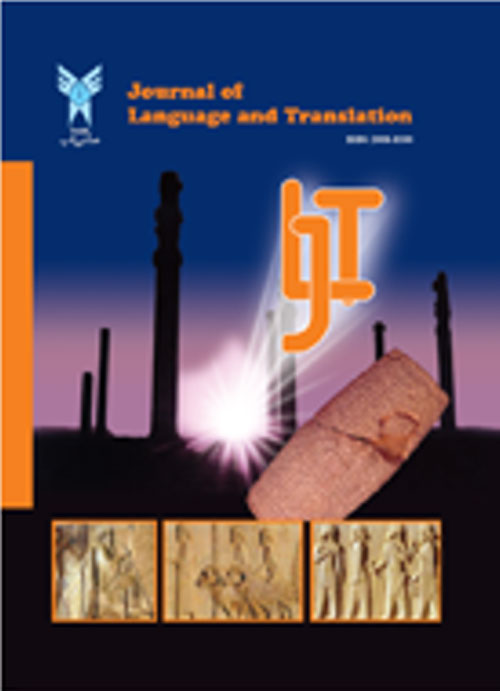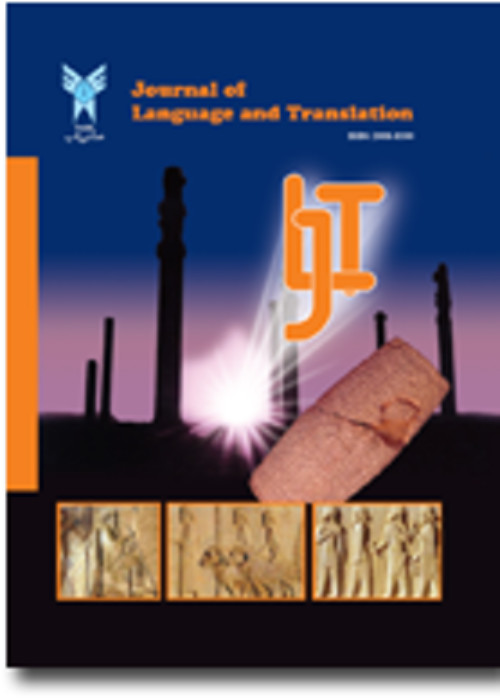فهرست مطالب

Journal of Language and Translation
Volume:7 Issue: 2, Summer 2017
- تاریخ انتشار: 1396/06/20
- تعداد عناوین: 7
-
-
Pages 1-19The present study was an attempt to find out whether there were any exclusive strategies regarding illustration in the rendition of children‟s illustrated books. Further, it investigated whether the existing intersemiotic models were sufficiently responsive to the demands of Iranian translators and children. Cases of the study included three children‟s illustrated story books for age groups B and C (Group B-children in the first grades of primary school/ Group C- children in the last grades of primary school) in two formats (the first one the original book, the second one the translated book). The utilized method for conducting this qualitative research was Grounded Theory. The research instruments were semi-structured interview and content analysis. The intersemiotic model of translation propounded by Aguiar and Quieroz and the hermeneutic approach of Steiner were chosen as the study framework. The interviewees were among stakeholders of children‟s literature; illustrators, translators and publishers. The findings revealed that there are no exclusive strategies as regards illustration. In addition, although the existing intersemiotic models are acceptable as foundational models, these models do not provide sufficient utility to decode every interfering factor in translation of children‟s illustrated books. Ultimately, the research resulted in a novel model for rendition of the children‟s illustrated books.Keywords: Age groups B, C, Children?s book, Illustration, Intersemiotic translation, Translation of children?s literature
-
Pages 21-33The Holy Quran, as an Arabic masterpiece, comprises great domains of syntactical, phonological, and semantic literary patterns. These patterns work as the shackle of translators. This study examined the application of the most common shift strategies in Catford‟s linguistic model for translation of topicalization in chapter 29 of the Holy Quran. The topicalized cases were compared to their counterparts in the three English renderings accomplished by Shakir, Nikayin, and Arberry. The study adopted Widdowson‟s classification based on syntactic, phonetic, and semantic features of the literary devices as the main framework and Halliday strategy for the exemplification of topicalization as the second framework. The findings of the study depict that, Arberry, Shakir and Nikayin have shown a considerably greater tendency towards employment of Category Shift than Level Shift. Among the category shifts, unit shift and Literal translation respectively enjoyed the highest frequency in the translation of topicalization. All the current translators preserved topicalization into target texts (un)intentionally. Finally, since the unit shift and literal translation proved the most frequently applied types of shifts in translation of syntactic patterns of religious texts from Arabic into English, the mentioned strategies may be considered as the part of schedule of translation workshops. Moreover, since syntactic literary devices includes parts of the meaning of source text, so translators should pay more attention to preserve this phenomenon in translation procedure.Keywords: comparative Study, Syntactic pattern, Topicalization, Translatability, Untranslatability
-
Pages 35-42This study aimed to investigate translators‟ approach in dealing with culture-specific items (CSI) in translation of fantasy fiction for children. For this purpose, the culture-specific items in Persian translations of John Ronald Reuel Tolkien‟s The Lord of the Rings and The Hobbit as well as Lewis‟s The Chronicles of Narnia were taken into consideration. Since children have limited amount of knowledge and language ability, translators of children‟s novels may encounter difficulties while dealing with culture-specific items. They cannot easily decide whether to domesticate or foreignize such items. The reason to select these novels was that these are highly fantasy, localized novels, and are expressive of the country where they were developed. They are also very popular novels and strongly related to fairy tales, myths, and legends. They demonstrate obvious deviation from reality and abound in culture-specific items. This descriptive research employed a parallel corpus study and a consolidation of translation procedures introduced by four theorists, i.e. Aixelá , Davies, Fernandes, and Klingberg as the theoretical framework. The results of the study were indicative of the translators‟ source-oriented tendency and the most frequently applied strategy was transliteration.Keywords: Children's literature, Culture-specific items, Fantasy fiction, literary translation
-
Pages 43-51Mark Twain made use of repetition and parallelism as two comedic literary devices to bring comic effect to the readers. Linguistic devices of humor, repetition and parallelism seemed to create many difficulties in the translation of literary texts. The present study applied Delabatista‟s strategies for translating wordplays such as repetition and parallelism in the translation of humorous texts from English into Persian. Material used in this study included the novel The Adventures of Huckleberry Finn written by Mark Twain and its two translations by Najaf Daryabandari and Hushang Pirnazar. According to the categorization of wordplays by Delabastita, repetitions and parallelism in this humorous novel were extracted and analyzed with their two translations according to Delabastita‟s strategies of translating pun. The results of this research study showed that the two translators used different strategies in translation of the humor. Daryabandari could transfer repetition and parallelism to the target text; however, Pirnazar was not successful in its transference and could not recreate humor in the target text.Keywords: Hushang Pirnazar, Mark Twain, Najaf Daryabandari, Translation of humor
-
Pages 53-62Translating the cultural terms in an understandable way for the target readers can be challenging for translators. Translators should be familiar with the cultures of both languages (i.e. source and target languages). The present study aimed to show that which cultural terms strategies are more common in translation of the novel titled For One More Day based on Aixela‟s model. This study also investigated the relevancy of the translation of the cultural terms to Aixela‟s Model. The corpus of this study was the novel For One More Day and its Persian translation under the title of Baraye Yek Rooz Bishtar, which has been translated by Manizheh Jalali. At the first step, the researchers extracted some part of the original book. They later took out the cultural terms from the original book and looked up for their equivalences in the Persian translation. After these steps, the researchers analyzed those equivalences based on Aixela‟s model. The findings of the study showed that the translator of the so-called novel used conservation and substitution strategies for translating the cultural terms.Keywords: Aixela's model, culture, Cultural terms, Strategy
-
Pages 63-71Pragmatics moves away from the word level and sentence level study of language towards the study of language in real-world context and at discourse level whereby two or more participants take part in conversation. There are moments when the speaker explicitly says something but the listener may have other interpretations and inferences from their statements. The aim of this study was to demonstrate that in some special situations or contexts, especially in comedy, conversational implicature is more likely to take place than others are. The researcher employed qualitative and quantitative content analysis (mixed method) to do our research to increase the validity and lower the subjectivity of findings. The first and second series of a British situation comedy called Blackadder‟, containing twelve episodes along with their Persian translations were selected as a source for our critical discourse analysis. The results of this study suggested that in comical contexts we seem to witness more cases of the non-observance of Grice's Maxims than other settings. An implication of this is the possibility that the violation of the cooperative principle occurs mostly with the aim of creating the feeling of humor.Keywords: Comedic genre, Cooperative principle, Critical discourse analysis, Implicature
-
Pages 73-79Metadiscourse features are those facets of a text, which make the organization of the text explicit, provide information about the writer's attitude toward the text content, and engage the reader in the interaction. This study interpreted metadiscourse markers in translated and non-translated persuasive texts. To this end, the researcher chose the translated versions of one of the leading newspapers in the United States, The New York Times, and the original versions of Hamshahri newspaper (an Iranian newspaper). Qualitative and quantitative analysis of both textual and interpersonal metadiscourse markers in second language (L2) translated and non-translated version of the opinion articles from The New York Times and Hamshahi (6 from each), found out how the translators organize their texts and how these organizations were related to the non-translated texts. Findings of the study revealed that textual and interpersonal metadiscourse markers were seen in both sets of data. Regarding the occurrences of textual metadiscourse categories and subcategories, the results showed significant differences between the two groups. It was, however, found that the Iranian writers used interpersonal markers significantly more than the Iranian translators did. The results suggested that metadiscourse markers have a prominent role to help the translators of opinion articles to understand the original texts.Keywords: Iranian columnists, metadiscourse markers, Newspaper discourse, Persian translators, Persuasive writing


